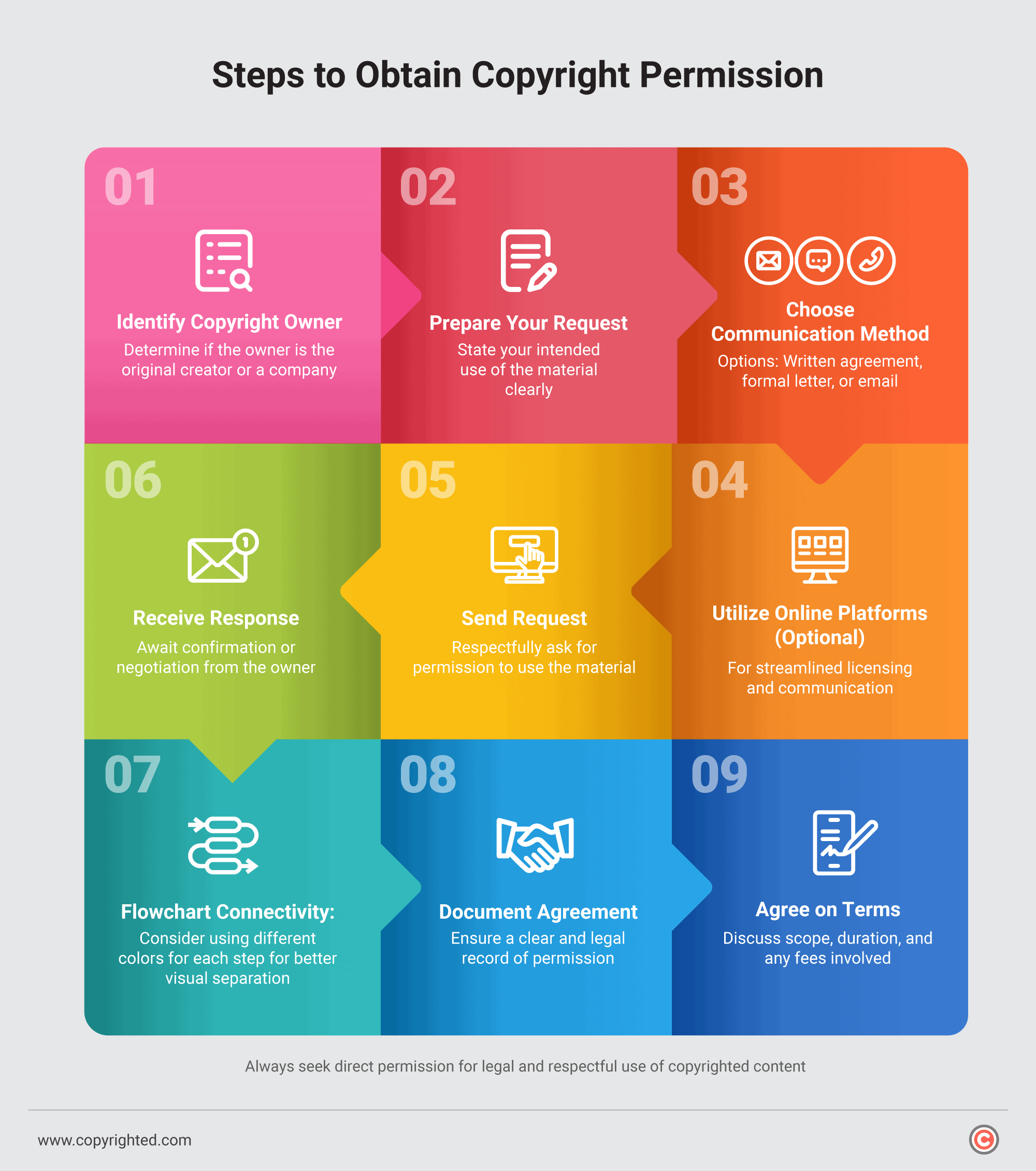Whether it’s for commercial or personal use, in a world brimming with creative content using copyrighted materials demands a cautious approach.
If you’re a content creator, educator, or online business owner, understanding fundamental copyright concepts is important to ensure you stay within legal boundaries.
This article will cover three key strategies to ensure the effective and lawful use of copyrighted materials in your creative endeavors.
- It’s important to prioritize obtaining permission or licenses when using copyrighted material.
- Fair use exceptions allow certain uses without permission in specific situations.
- Some common fair-use exceptions include commentary, criticism, parody, news reporting, research, and teaching.
Table of Contents
How Do You Use Copyrighted Materials?

Using copyrighted materials requires careful consideration and adherence to legal principles. I’ll walk you through effective methods for integrating copyrighted content into your projects while ensuring legal compliance.
Obtain Permission From the Copyright Holder
Getting permission from the copyright owner is the best way to use copyrighted work in your projects.
The first step here is to find out who owns the rights, which could be the original creator or a company. After that, you may ask them directly for permission, explaining how you plan to use their copyrighted work.
This can be initiated through various means, including written agreements, formal letters, or electronic communication such as email.
Nowadays, there are online platforms that make this process easier.
These platforms often streamline the process by providing standardized licenses and facilitating communication between content creators and those seeking permission. The copyright holder may specify the terms and conditions of use, including the scope, duration, and any associated fees.
Getting explicit permission this way is a clear and legal way to use the copyrighted material. It ensures you follow copyright rules and creates a documented agreement that protects both parties.
Whether you do it the traditional way or use modern platforms, asking the copyright owner directly is a respectful and responsible way to use creative content.
If you’re wondering, “Can you buy copyrighted work instead of licensing it?” the answer is yes. Ownership can be transferred, but it typically requires a formal agreement outlining the terms of purchase.
Obtain a License to Allow Your Use Case
Acquiring a license is another effective strategy to use copyrighted materials legally. Many copyright holders offer licenses that outline the terms and conditions under which their work can be used.
These licenses serve as legal agreements that clearly define essential aspects such as the duration, scope, and intended purpose of the permitted use.
The terms outlined in the license not only provide clarity on the extent of usage but also contribute to a transparent and mutually agreed-upon understanding between the user and the copyright holder.
Whether it’s a music track, an image, or a written work, licensing ensures you have the legal right to incorporate it into your projects.
This method ensures that you have the legal rights to use copyrighted material in your creative projects, promoting a responsible and compliant content creation approach.
Utilize and Determine the Fair Use
Understanding the concept of fair use is also important if you want to use copyrighted intellectual property without asking for permission.
Fair use allows for the use of an original work, under certain circumstances, without the need for permission or payment. While the application of fair use can be subjective and is often determined on a case-by-case basis, there are common exceptions recognized by the copyright law.
Section 107 of the Copyright Act of 1986 states that fair use of copyrighted material “for purposes such as criticism, comment, news reporting, teaching, scholarship, or research, is not an infringement of copyright.”
Let’s discuss these exceptions further:
- Commentary: This exception allows you to use copyrighted material when providing insights, analysis, or expressing your thoughts about it. It’s about offering valuable perspectives or interpretations without necessarily replicating the original work.
- Criticism: This involves incorporating copyrighted material to express disapproval or critique and applies to various forms of art, literature, music, or any other creative work. If you’re creating content to analyze and showcase aspects you don’t agree with or find fault in, you’re using copyrighted material for criticism.
- Parody: Parody allows you to create a humorous or satirical imitation of the original work. It involves using elements of the original work to create something new that adds humor, satire, or a playful twist.
- News reporting: When you’re sharing news, discussing events, or presenting factual information, you might need to use copyrighted material. Reporting allows you to incorporate copyrighted material to enhance the accuracy and informativeness of your reporting.
- Research: If you’re using parts of a copyrighted book, painting, or music for academic or research purposes, it’s allowed under fair use. This exception recognizes the importance of using copyrighted material for educational or scholarly exploration.
- Teaching: Teachers often use copyrighted material in their lessons, such as showing a short clip from a documentary to help students understand a topic better. Using copyrighted material for instructional purposes is generally considered fair use, allowing educators to enrich their teaching materials and engage students effectively.
While these fair use exceptions provide flexibility, it’s also important to assess each use case individually considering the four factors that the U.S. Copyright law examines.
These four factors collectively guide the determination of whether a particular use qualifies as fair use, with their interpretation often being context-specific and intricate.
Firstly, it evaluates the purpose and character of the use, discerning whether it introduces transformative elements or merely replicates the original. The nature of the copyrighted work is also considered, distinguishing between works that are more factual versus those of a creative nature.
Additionally, the law scrutinizes the amount and substantiality of the portion used concerning the entire copyrighted work. Lastly, the effect on the potential market or value of the copyrighted work resulting from the use is taken into account.
This is exactly why it is important to understand copyright and fair use, not just to stay within legal bounds but to also empower yourself to use creative works ethically and effectively.
Wrapping Up
When dealing with creative content, it’s essential to handle copyrighted materials with care, whether for personal or business purposes. Having a solid grasp of basic copyright principles is important for staying within legal boundaries.
This guide explored three strategies for legally using copyrighted materials: get permission, use licenses, and understand fair use. Each strategy comes with its unique benefits, allowing you to customize your approach based on your specific needs and the nature of the copyrighted material.
Frequently Asked Questions
What is considered copyrighted material?
Copyrighted material includes various creative works such as literature, music, art, and software. Any original work fixed in a tangible medium of expression is automatically copyrighted.
Does copyright apply to personal use?
Copyright generally applies to all uses of copyrighted material, including personal use. However, specific conditions may vary, and it’s essential to understand the nature of the material and its intended use.
Can you copy copyrighted material?
Copying copyrighted material without permission is generally not allowed. Copyright holders have exclusive rights to reproduce, distribute, and display their work.
What happens if you use something copyrighted without permission?
Using copyrighted material without permission can lead to copyright infringement. Consequences may include legal action, monetary penalties, project disruptions, and damage to your reputation as a content creator.
What is fair use, and how does it apply?
Fair use is a legal doctrine allowing the use of copyrighted material under certain circumstances, such as criticism, commentary, news reporting, teaching, scholarship, or research. Its application is case-specific and subject to evaluation.
Are there alternatives to using copyrighted material without permission?
Yes, alternatives include obtaining permission from the copyright holder, acquiring a license, utilizing public domain works, or exploring royalty-free libraries.


